Erowid Crew Adventure Photography
South American Entheovoyeurism
by Sylvia Thyssen & Jon Hanna
Nov 2011
Citation: Thyssen S, Hanna J. "Erowid Crew Adventure Photography: South American Entheovoyeurism". Erowid Extracts. Nov 2011; 21:10-17.
In 2011, several of the Erowid crew, including Sylvia Thyssen and Jon Hanna, independently traveled within South America, visiting Argentina, Bolivia, Brazil, Paraguay, and Peru. They captured over 2,000 photos and videos during their trips, featuring glimpses into the culture and business of psychoactives in South America. Ayahuasca, coca, virility-boosting concoctions, local flora, entheotourism, the curiously foreign, and the beautiful attracted the crew's attention.
Aside from the bustling Andean city of Cuzco, Peru, where many shopkeepers cater to gringos' entheogenic curiosity, the prevailing theme for the commercial sale of psychoactives seen during these travels was the quotidian pursuit of health, vitality, and the good life. Experientially dense, traveling in South America affords opportunities to touch on or dive into the culturally rich and politically complex mash-up of the traditional and modern use of psychoactives.
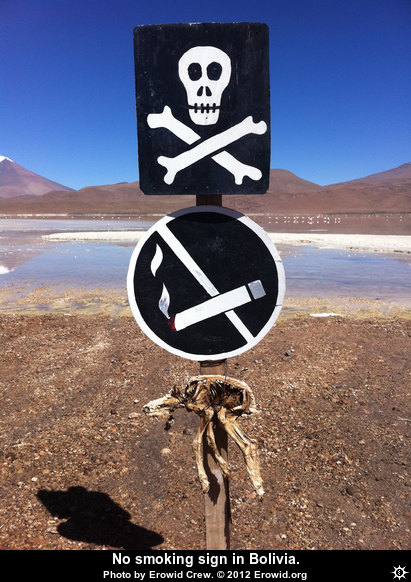 Why a llama fetus accompanies a skull and crossbones and
Why a llama fetus accompanies a skull and crossbones and
"no smoking" sign remains a mystery. [Altiplano, Bolivia]
|
|---|
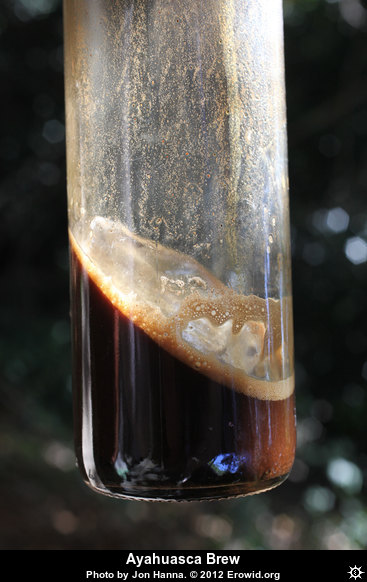 Bottle of ayahuasca brewed by a Santo Daime branch.
Bottle of ayahuasca brewed by a Santo Daime branch.
[Vila Camboinha, Brazil]
|
|---|
|
|---|
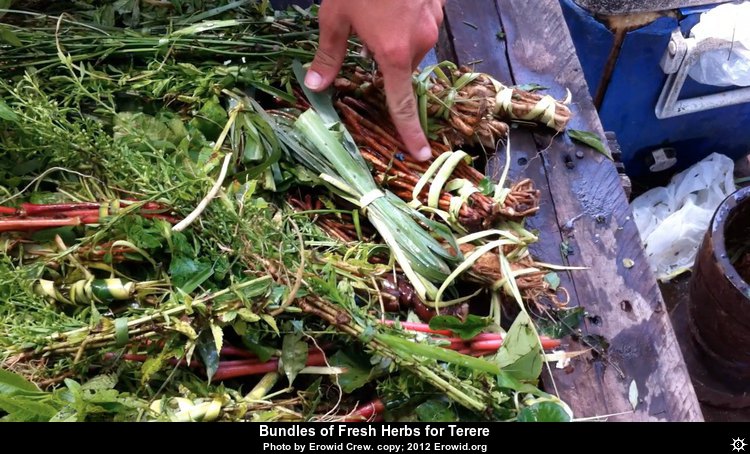 Bundles of fresh herbs for tereré are sold in the market.
Bundles of fresh herbs for tereré are sold in the market.
A tradition of the Guarani, the indigenous people of Paraguay, tereré is a cold infusion of herbs such as yerba mate, yerba luisa (lemon grass), and mint. The popular beverage is repeatedly imbibed throughout the day [Asunción, Paraguay]
|
|---|
|
|---|
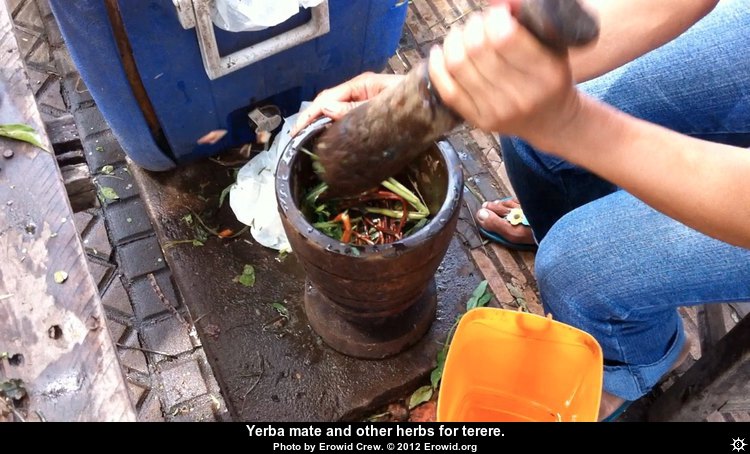 One of the many tereré vendors on the main square mashes herbs for a fresh infusion with a mortar and pestle. [Asunción, Paraguay]
One of the many tereré vendors on the main square mashes herbs for a fresh infusion with a mortar and pestle. [Asunción, Paraguay]
|
|---|
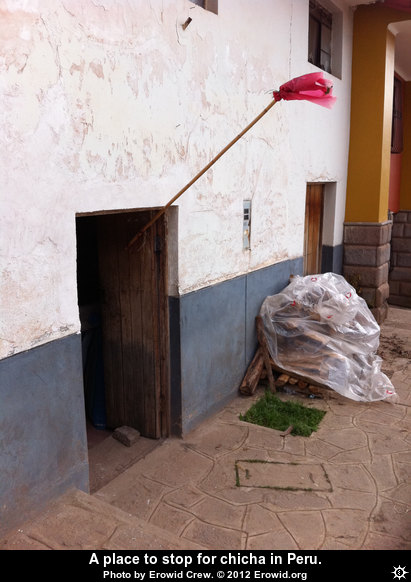 Chicha is a common fermented drink made from corn or other grains, varying by region. To advertise fresh chicha in a semipublic drinking house or restaurant, hosts tie a red plastic bag to a pole--a modern replacement for the more traditional hanging of red geraniums. [Chinchero, Peru]
Chicha is a common fermented drink made from corn or other grains, varying by region. To advertise fresh chicha in a semipublic drinking house or restaurant, hosts tie a red plastic bag to a pole--a modern replacement for the more traditional hanging of red geraniums. [Chinchero, Peru]
|
|---|
|
|---|
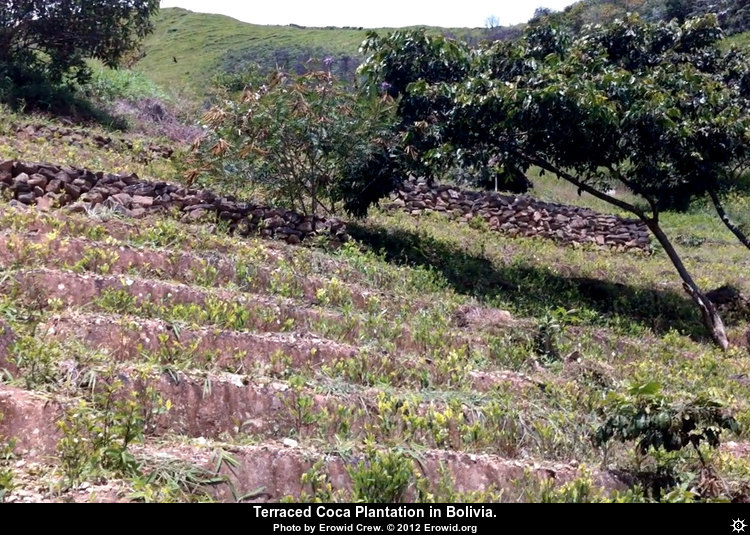 In the lush Yungas region of Bolivia, small parcels of land are allotted to families for coca cultivation, which is highly regulated. The soil of this terraced coca plantation is packed and rocky. [near Coroico, Bolivia]
In the lush Yungas region of Bolivia, small parcels of land are allotted to families for coca cultivation, which is highly regulated. The soil of this terraced coca plantation is packed and rocky. [near Coroico, Bolivia]
|
|---|
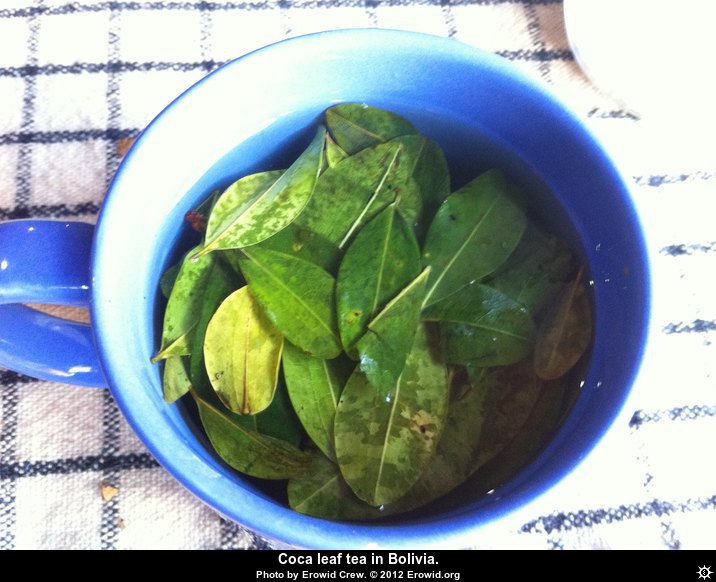 Coca tea is ubiquitous in Bolivia and Peru. Although coca is mixed with lime (calcium oxide) or sodium bicarbonate prior to buccal administration, tea is brewed with coca leaves alone, and has a pleasant, earthy taste. [La Paz, Bolivia]
Coca tea is ubiquitous in Bolivia and Peru. Although coca is mixed with lime (calcium oxide) or sodium bicarbonate prior to buccal administration, tea is brewed with coca leaves alone, and has a pleasant, earthy taste. [La Paz, Bolivia]
|
|---|
|
|---|
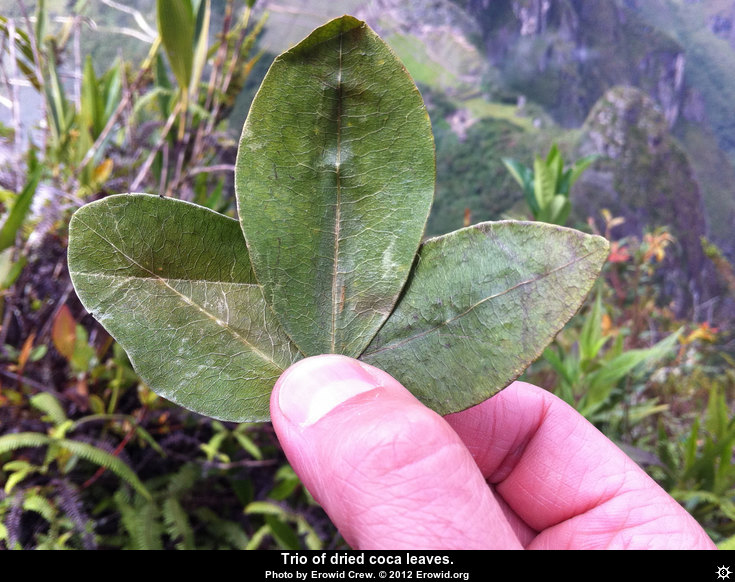 Offerings of coca leaves, placed on a "mesa" or altar, are traditionally
Offerings of coca leaves, placed on a "mesa" or altar, are traditionally
arranged in threes. [overlooking Machu Picchu, Peru]
|
|---|
 A shopkeeper displays his coca in a large cloth sack, dispensing leaves in 500 gram bags. [Tupiza, Bolivia]
A shopkeeper displays his coca in a large cloth sack, dispensing leaves in 500 gram bags. [Tupiza, Bolivia]
|
|---|
|
|---|
 Coca leaves and sodium bicarbonate labeled "El Recreo" ("recreation" or "relaxation") are sold together at city markets and sidewalk stalls.
Coca leaves and sodium bicarbonate labeled "El Recreo" ("recreation" or "relaxation") are sold together at city markets and sidewalk stalls.
As a base, sodium bicarbonate aids in releasing alkaloids from the plant when it is combined with leaves and chewed and held in the mouth. Shown here with no-nonsense "potable alcohol". [La Paz, Bolivia]
|
|---|
|
|---|
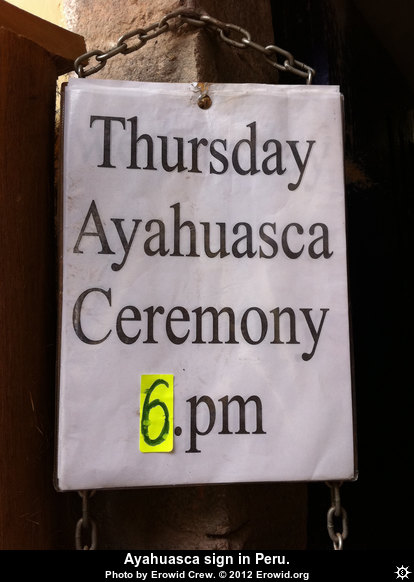 Some Cuzco shops and backpacker hotels openly advertise their daily ayahuasca ceremonies outside of their premises, to attract passersby. [Cuzco, Peru]
Some Cuzco shops and backpacker hotels openly advertise their daily ayahuasca ceremonies outside of their premises, to attract passersby. [Cuzco, Peru]
|
|---|
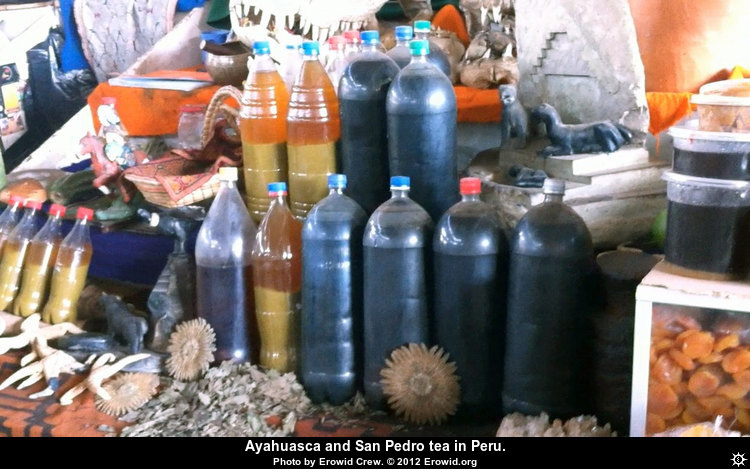 In the central market, San Pedro tea and ayahuasca are displayed in dusty soda bottles alongside altar items and dried cuttings of Banisteriopsis caapi vine and Trichocereus pachanoi cactus. [Cuzco, Peru]
In the central market, San Pedro tea and ayahuasca are displayed in dusty soda bottles alongside altar items and dried cuttings of Banisteriopsis caapi vine and Trichocereus pachanoi cactus. [Cuzco, Peru]
|
|---|
|
|---|
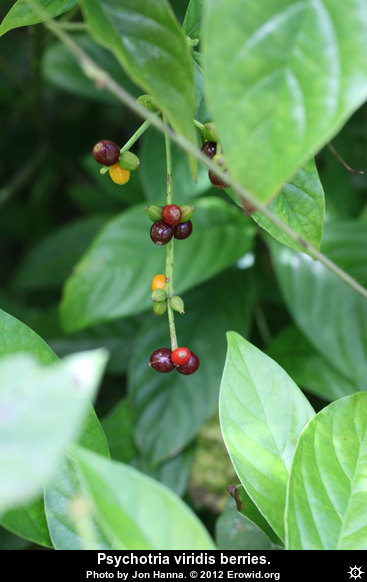 Ripening berries hang from this chacruna (Psychotria viridis) shrub, a major DMT source plant used in ayahuasca brews. [Vila Camboinha, Brazil]
Ripening berries hang from this chacruna (Psychotria viridis) shrub, a major DMT source plant used in ayahuasca brews. [Vila Camboinha, Brazil]
|
|---|
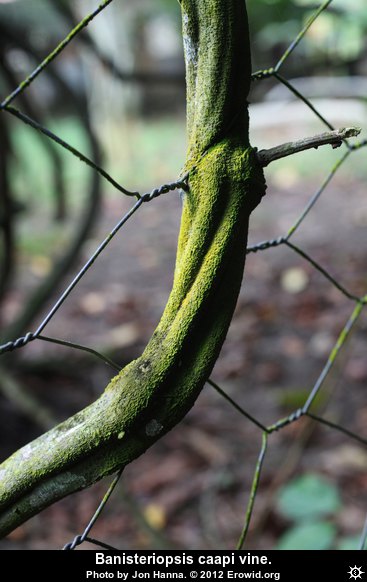 Some areas of Brazil are particularly well suited for growing ayahuasca (Banisteriopsis caapi), the jungle vine known for its legal spiritual use by Brazilian religious groups such as the União do Vegetal and the Santo Daime. [Vila Camboinha, Brazil]
Some areas of Brazil are particularly well suited for growing ayahuasca (Banisteriopsis caapi), the jungle vine known for its legal spiritual use by Brazilian religious groups such as the União do Vegetal and the Santo Daime. [Vila Camboinha, Brazil]
|
|---|
|
|---|
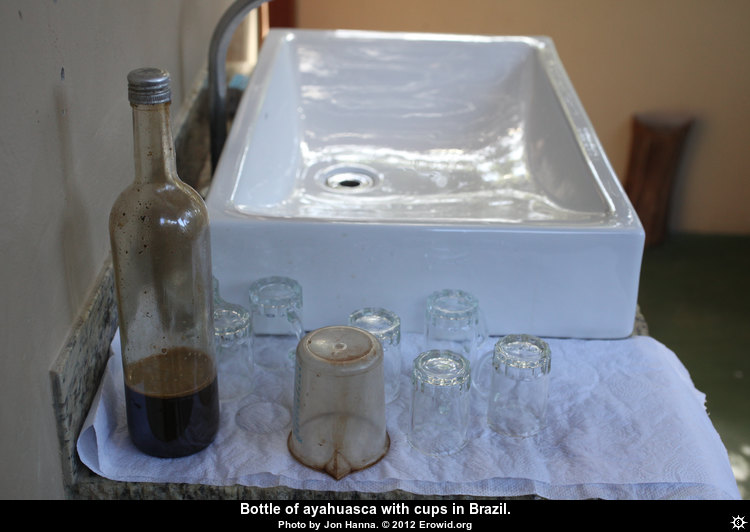 This bottle of ayahuasca was brewed by a Santo Daime branch for TheVine Center. The ayahuasca is carefully portioned out using a measuring cup. Commonly served doses range from 50 to 100 ml. Two to three hours later, ceremony participants are offered the option of taking a second dose. [Vila Camboinha, Brazil]
This bottle of ayahuasca was brewed by a Santo Daime branch for TheVine Center. The ayahuasca is carefully portioned out using a measuring cup. Commonly served doses range from 50 to 100 ml. Two to three hours later, ceremony participants are offered the option of taking a second dose. [Vila Camboinha, Brazil]
|
|---|
|
|---|
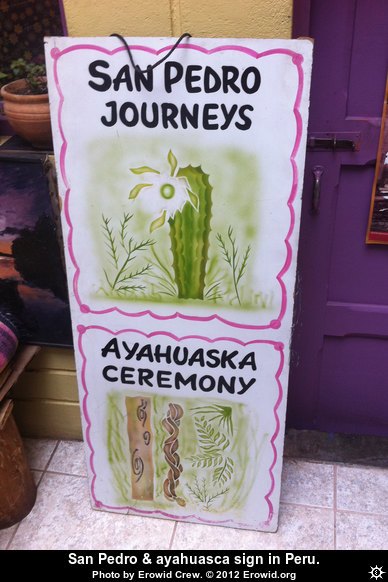 Some hotels and New Age centers offer a choice between ayahuasca and San Pedro (Trichocereus pachanoi) journeys. [Cuzco, Peru]
Some hotels and New Age centers offer a choice between ayahuasca and San Pedro (Trichocereus pachanoi) journeys. [Cuzco, Peru]
|
|---|
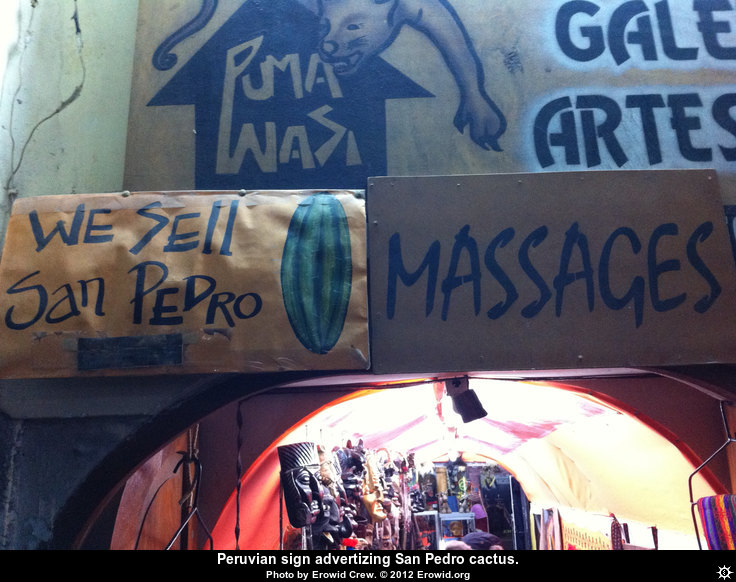 For the DIY approach, tourists can buy dried or fresh cactus in shops or the central market. Signs in front of other establishments advertise sessions with kampo, the psychoactive secretion from a frog (Phyllomedusa bicolor) that is introduced through burns, cuts, or abrasions in the skin. [Cuzco, Peru]
For the DIY approach, tourists can buy dried or fresh cactus in shops or the central market. Signs in front of other establishments advertise sessions with kampo, the psychoactive secretion from a frog (Phyllomedusa bicolor) that is introduced through burns, cuts, or abrasions in the skin. [Cuzco, Peru]
|
|---|
|
|---|
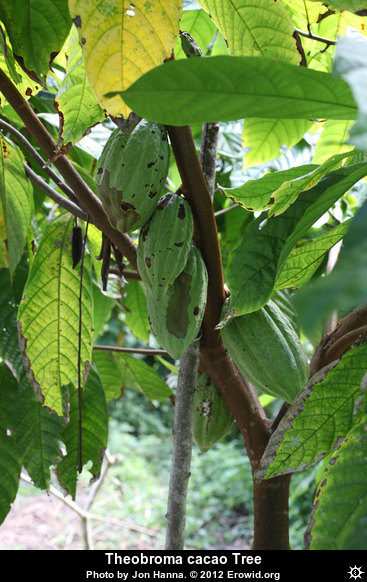 Theobroma cacao fruit on the tree.
Theobroma cacao fruit on the tree.
[Vila Camboinha, Brazil]
|
|---|
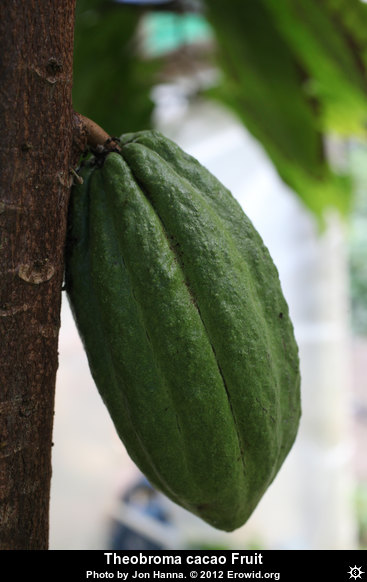 Casually planted in many yards, Theobroma cacao (chocolate) trees produce a large fruit that is made into a juice and assorted liquors. Eaten fresh, it has a sweet-sour flavor somewhat reminiscent of moist bread. [Villa Camboinha, Brazil]
Casually planted in many yards, Theobroma cacao (chocolate) trees produce a large fruit that is made into a juice and assorted liquors. Eaten fresh, it has a sweet-sour flavor somewhat reminiscent of moist bread. [Villa Camboinha, Brazil]
|
|---|
|
|---|
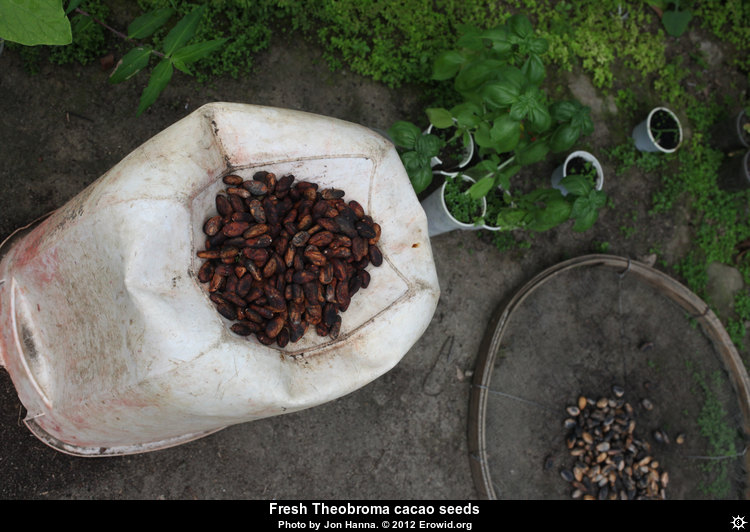 After the fruit is consumed (or discarded), the T. cacao seeds are dried on a screen. Once dry, they can be consumed raw as a mildly stimulating snack. However, many people toast them to make them crunchier before eating them, blending them in milk, or making their own chocolate confections. [Vila Camboinha, Brazil]
After the fruit is consumed (or discarded), the T. cacao seeds are dried on a screen. Once dry, they can be consumed raw as a mildly stimulating snack. However, many people toast them to make them crunchier before eating them, blending them in milk, or making their own chocolate confections. [Vila Camboinha, Brazil]
|
|---|
|
|---|
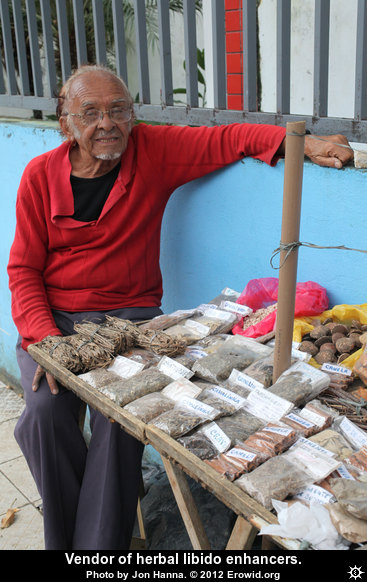 Sporting an "I know what you're interested in" smile, this wizened character offered herbal libido enhancers, such as the Brazilian plant marapuama (Ptychopetalum olacoides). [Itacaré, Brazil]
Sporting an "I know what you're interested in" smile, this wizened character offered herbal libido enhancers, such as the Brazilian plant marapuama (Ptychopetalum olacoides). [Itacaré, Brazil]
|
|---|
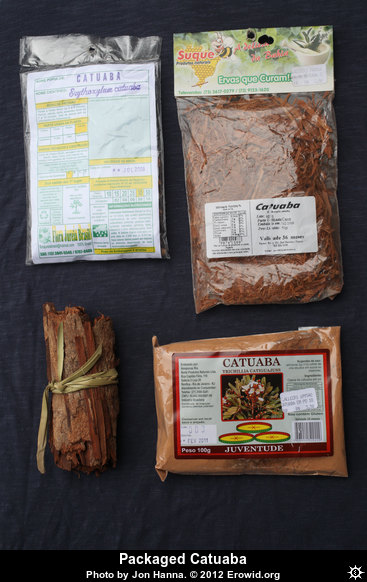 Claimed to be a central nervous system stimulant, as well as an aphrodisiac and impotence cure, the bark from several plant species are sold in Brazil using the same name: "catuaba". Two of the commonly available species are Erythroxylum vacciniifolium (often sold as E. catuba) and Trichilia catigua. [Ilhéus, Brazil]
Claimed to be a central nervous system stimulant, as well as an aphrodisiac and impotence cure, the bark from several plant species are sold in Brazil using the same name: "catuaba". Two of the commonly available species are Erythroxylum vacciniifolium (often sold as E. catuba) and Trichilia catigua. [Ilhéus, Brazil]
|
|---|
|
|---|
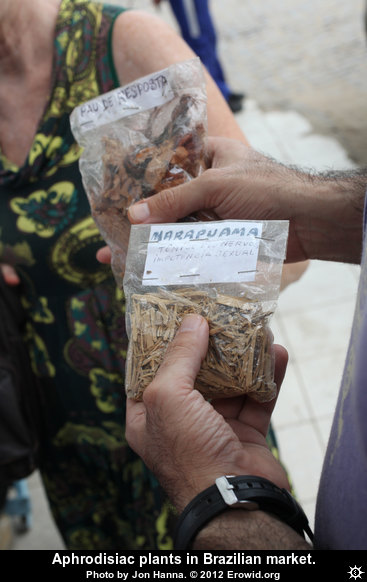 The Brazilian native plant pau de resposta (Anemopaegma arvense) is sold as an aphrodisiac, while marapuama ("muira puama", "potency wood") is not only reported to boost libido, but is also said to induce relaxation and cure sexual impotence. [Itacaré, Brazil]
The Brazilian native plant pau de resposta (Anemopaegma arvense) is sold as an aphrodisiac, while marapuama ("muira puama", "potency wood") is not only reported to boost libido, but is also said to induce relaxation and cure sexual impotence. [Itacaré, Brazil]
|
|---|
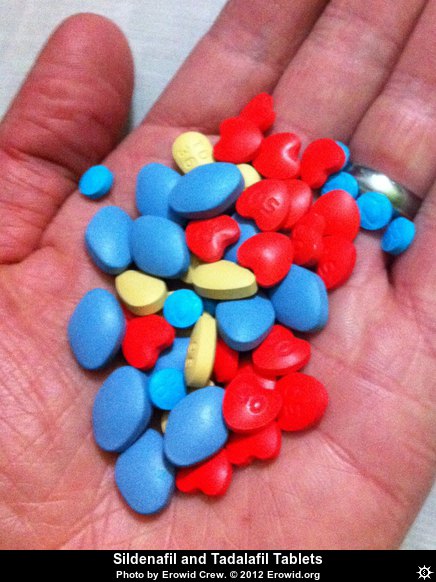 Herbal products aren't the only available option in South America, of course. Multiple doses and brands of blue and red sildenafil (generic Viagra) and yellow tadalafil (generic Cialis) are offered in small "farmacias". Note the heart-shaped pills! [tablets pictured were obtained in Argentina, Paraguay, and Bolivia]
Herbal products aren't the only available option in South America, of course. Multiple doses and brands of blue and red sildenafil (generic Viagra) and yellow tadalafil (generic Cialis) are offered in small "farmacias". Note the heart-shaped pills! [tablets pictured were obtained in Argentina, Paraguay, and Bolivia]
|
|---|
|
|---|

























